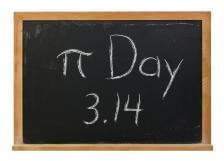3.14 Fun Facts About Pi
Happy Pi Day 2017! What is pi? Why does it have its own holiday? And what are some fun (and useful) facts to know about this famous number? Keep on reading to find out!
Jason Marshall, PhD
Listen
3.14 Fun Facts About Pi

After all, how many opportunities do we get to party in the name of math? Not a ton, right? But in recent years, Pi Day has become an exception to this rule. Sure, it’s kind of silly. But it’s fun, too—and I’m all for that combo.
But did you know that next year’s Pi Day is going to be a really special one? And the one after that, too? In fact, they’re so special that you’d have to live another century before seeing another one like them.
To prepare, today we’re going to learn 3.14 fun facts about pi that you can share with all of your Pi Day friends next year. And we’re also going to learn exactly why the next two Pi Days will be once in a lifetime celebrations..
Fun Fact #1: Why Is Pi Day March 14?
The most interesting question about Pi Day is: Why is it celebrated on March 14? Believe it or not, the answer to this little mystery goes way back to the 14th day of the 3rd month of the rule of famed Roman Emperer Tiberius. You see, at that time…
Uh, wait a minute… Really? No, I’m just kidding. The answer is much simpler. In fact, as you probably already know, Pi Day is celebrated on March 14 simply because the number pi has an approximate value of 3.14…as in 3/14…as in March 14. No big surprise.
But still: Why March 14? By which I mean: Why is pi equal to approximately 3.14?
Pi is approximately 3.14 simply because that’s what it is.
As we learned in the episode What Is Pi? if you draw a circle, measure both the distance around the circle—aka, its circumference—and its diameter, and then divide the circumference by the diameter, you’ll always get a number that’s approximately 3.14. So that’s why pi is 3.14—and why Pi Day is March 14—right?
Well, that certainly gives us one way to calculate pi, but it doesn’t actually tell us once-and-for-all why it has that value. Because the weird thing is that there are ways to calculate pi that have nothing to do with circles. For example, the problem known as “Buffon’s needle” shows that the probability that a grain of rice tossed randomly onto a sheet of lined paper will land touching a line is related to the value of pi. Strange, but true.
My point is that there isn’t actually a single “why.” Pi is approximately 3.14 simply because that’s what it is. And that’s why we celebrate it on March 14.
Fun Fact #2: How Is π Related to a Year?
Our second fun fact about pi is a bit less philosophical in nature, and it’s something that can actually come in quite handy on occasion. In fact, it’s a number that’s used by professional astronomers (myself included) all the time to make quick and dirty estimates.
The fun fact that I’m refering to is that there are roughly pi x 10-million seconds in a year. Of course, that’s not the precise number. If you work it out, you’ll find that there are actually 31,536,000 seconds in a year. But pi x 10-million is usually good enough…and it’s certainly a lot easier to remember.
So the next time you find yourself needing to do a calculation dealing with seconds and years—which for many of you might happen every pi x 10-million seconds or so—remember this handy conversion.
Fun Fact #3: How Is π Related to a Lifetime?
Our third fun fact for today is also about pi and time. Namely, it’s that pi seconds is very close to 1 nanocentury. In other words, 3.14 seconds is about 1-billionth of a century. Of course, this is a completely ridiculous number. After all, it’s crazy to measure tiny things (like seconds) in terms of comparatively big things (like centuries), right?
A lifetime of 1 century will be lucky enough to span about pi-billion seconds.
Well, perhaps it’s not as crazy as it seems. Because if we turn this relationship upside down, we come up with a number that’s most certainly not crazy. In particular, by inverting the fact that pi seconds is approximately 1 nanocentury, we learn that a lifetime of 1 century will be lucky enough to span about pi-billion seconds.
Which is kind of an interesting number to think about. Pi-billion seconds is a lot of seconds. Well, sort of. I mean, it’s comforting to know that human lifetimes are measured in billions (and not millions) of seconds, but trillions (or quadrillions) would’ve been nice. Which is a good reminder to all of us that we should do our best to make as many of those roughly pi-billion seconds count.
Fun Fact #3.14: Why Will Pi Day 2015 Be So Special?
And finally for today, why do I claim that Pi Day 2015 and 2016 are going to be the most special Pi Days in a century?
The answer is simple. We all know that pi is approximately equal to 3.14. And we also know that pi is an irrational number—which means that its digits don’t stop there. What are the next two digits of pi? Yep, you guessed it: 3.1415—in other words, 3/14/15…March 14, 2015.
OK, that makes sense. But why do I claim that Pi Day 2016 will also be special? Because if we include one more decimal digit in our approximation of pi, we get the number 3.14159. And if we’re interpreting this number as a date, that final 9 means that we should round the 5 up to a 6—giving us 3.1416: March 14, 2016.
Yes, I know this is all kind of silly. But as I said before, it’s also kind of fun. And that’s something to be celebrated.
Wrap Up

Please be sure to check out my book The Math Dude’s Quick and Dirty Guide to Algebra. And remember to become a fan of the Math Dude on Facebook where you’ll find lots of great math posted throughout the week. If you’re on Twitter, please follow me there, too.
Until next time, this is Jason Marshall with The Math Dude’s Quick and Dirty Tips to Make Math Easier. Thanks for reading, math fans!
Pi day image from Shutterstock.

